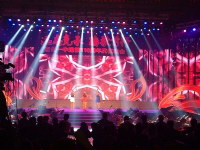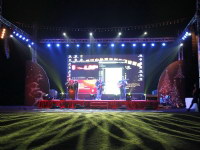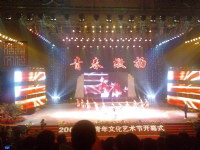The light and color of stage lighting
In the development of stage lighting drama, some stage art masters once advocated the organic integration of light and scenery. Swiss stage artist Apia’s "Integrated Art"; Czech stage artist Svoboda emphasized that the stage design as "solidified music" should be organically integrated with the flowing light of music; Chinese American stage art Mr. Li Mingjue also emphasized that “the setting and lighting design must cooperate very well...”
Architecture, sculpture, and painting that we usually understand are art that keeps time and space relatively eternal in plane or three-dimensional. However, performance art, as a comprehensive time and space art, needs a space to maintain the relationship between performances-theater or performance venue. In performances that transcend time and space, stage artists jointly constitute a visual and auditory creative space with multi-dimensional factors such as sound, light, color, and shape, and continue to develop over time, as the plot and scene change. Whether it’s the turning point of the drama plot or the performance of opera singing and dancing, at the same time, the performance lighting changes in the audience’s vision or unknowingly changes the light and shade effects, changes in the shape and space or the functions of the lighting equipment itself. Kind of visual performance. Participate in the performance by shaping the image, rendering the color, changing the rhythm, etc., and form a special stage performance space atmosphere with visual vocabulary, which affects the emotional changes of the audience and constitutes a specific space that is consistent with the content of the stage performance in which the scene, actors, and audience interact .
The stage lighting system design is configured in accordance with the rules and special use requirements of stage art performances. The purpose is to design and configure the lighting technology equipment required for the reproduction process of various performing arts according to the system engineering, so that the stage lighting system is accurate and complete. The land serves the art exhibition.
In stage lighting design, the most important thing is the use of light and color. The so-called light color, that is, the color of light, is the most emotional modeling element in stage lighting. It is used to render the mood and atmosphere of the drama, to highlight the thoughts and emotions of the characters; to express space and time; to control the rhythm of the performance, etc. It plays a very important role. At the same time, the scenes, costumes and makeup props displayed on the stage are "secondary coloring" to unify and coordinate the colors of the stage pictures.
The combination of light and color is the most important means for stage lighting to create artistic effects. The color of light largely determines the tone of the stage picture. The stimulating color light is used to create the feeling of beauty and affect the psychology of the audience. It has great expressiveness and appeal, and has become the most used method in today's drama performance. Arnheim pointed out in his book "Art and Visual Perception": "Colors can express emotions powerfully... the effects of color are very direct and spontaneous." Once the color of light penetrates the waves of dramatic emotions, the theater's The atmosphere becomes active. In the process of using stage lighting and color, the first thing to consider is the grasp of the large tones of the entire stage picture, which is similar to the painting procedure. Usually, in the initial stage of painting, what we think about is not "how to paint this apple" or "how to express this vase", but to first determine a big hue for our painting, and then do not affect In this large tonal range, local details such as "apple" and "vase" are depicted. In theatrical performances, the overall tone of the stage screen gives the audience the most intuitive first visual impression, which is undoubtedly the most eye-catching and most important, and will play a powerful role in the expression of the dramatic mood and the audience's visual reading.
In painting art, hue is the main theme of a picture; in drama art, the hue rendered by stage lighting can be called the "emotional score" of the entire drama. For lighting designers, color tone is the overall color grasp of all aesthetic objects on the stage. Since color is affected by the influence of adjacent colors, a color does not only exist in itself, its properties come from the surrounding things. Therefore, for creation or design, the combination of colors forms the hue; and the hue is determined by the overall intention of organizing the color. In many stage pictures that fit the context of the drama, a reasonable color tone is the commander and commander of the stage lighting design works. In practical applications, it should be flexibly applied and selected according to the needs of the performance objects and drama emotions in theatrical performance.
On the stage, there are many colors available for lighting design. This requires lighting designers to refine and choose through their own overall grasp of the drama, stage space and character scenery, and seek the main color among multiple color relationships. When depicting the stage picture, we usually use the following methods to choose the use of light and color, and adjust the color of the picture in line with the designer's intention and thought.
Light color is one of the more important elements of stage lighting, and also the most complicated one.
Color can arouse people's aesthetic experience, and people's memory can produce similar associations. For example, red can make people associate both pros and cons. They think of fire and blood, and then think of the sun, weddings, wars, etc., and feel warm, warm, festive, or terror, pain, and death.
In stage performances, lighting design often uses the symbol or meaning of light and color to express and contrast the plot and render the atmosphere. However, because of differences in group culture and personal habits and moods, the associations and feelings of colors are also different and cannot be generalized. The colors are strong and rich, and the image is bright and prominent. The actors' facial makeup, costumes, props, and performances are strong and beautiful in form. These visual elements alone can give the audience a strong visual stimulation. If you add "multicolored" lights, it will easily backfire. . In modern dance performances, white light is also a very important stage performance method. The pure light color makes the audience's attention more focused on the beauty of the actor's figure, movement and posture. Of course, this white light expression technique is completely different from the bright white light expression technique in traditional Chinese opera. The lighting design of modern dance usually interprets the rhythm and beauty of dance through the combination of white light with different angles and brightness.
In stage performances, stage lighting often needs to simulate a certain scene in real life. Sometimes, not only light is needed to create a space for theatrical environment, but also to show the time when the plot occurred. At this time, the main performance of the light source confused the entire stage space, and the stage picture is unified under the influence of this light source to form a certain tone. The streets illuminated by the moonlight shown on the stage, the huts under the oil lamps...all present the tones of a certain atmosphere. Lighting design needs to observe the lighting effects in daily life, determine the nature of the main light source and the best lighting settings on the stage, emphasize the sense of light and color, and of course pay attention to the lighting effects of the entire stage space, background and main performance light source Echoes. The lighting design should be based on the requirements of the script theme, plot, director and many other factors. When using color light, it should be bright and dark, cold and warm, complicated and simple, with ups and downs to match the plot and the performance of the characters. Consider the use of the color of the whole play, and obtain the ups and downs of the light color of the whole play through the change of the main tune between the sessions. Reasonable use of light colors and color selection are necessary for a successful stage lighting design work, but it is not the only one. In the process of lighting design, even in the use of lighting to express natural scenes, the establishment of tones should not be merely an objective record of indifferent, let alone advocating the splendor of colors blindly. This choice should have a basis. This basis is "drama", which reflects the unity of the objective images and subjective emotions of "drama" and "human" in the color of the light. In this way, the use of color as a vocabulary of lighting is truly artistic, and it truly achieves "fortune from outside teachers, to find the source of heart". The objectively existing colors or tones themselves can only arouse the different emotions of the viewers when they are integrated into the drama. People have lived in a world full of colors for generations. The changes and forms of colors will have direct or indirect effects on people's psychology and physiology. In the process of forming life experience, due to the material characteristics of color, through the accumulation of time, it will naturally cause people to have various feelings, such as the red of passion, the yellow of hope, and the gloomy gray associated with sadness and horror. Colors. In the long-term stage art practice, people have fully proved that color plays an unparalleled important role in activating the atmosphere of the performance, controlling the mood of the drama, and describing the psychology of the characters. The use of light and color is an important part of stage lighting design as a visual art. Link. What the audience sees through the stage is the tone of the image constructed with light, but what they feel is the mood and feelings of the characters in the script or the play.
Complete the required overall atmosphere to make the performance more perfect. In terms of showing the character’s psychology, the lighting design can be based on the requirements of the script character and the director, combined with the scheduling of the character, using the method of color and light contrast, the method of enhancing the brightness or changing the light color, to achieve the purpose of highlighting the main character, and let the color be based on the performance The content and the characters are jumping, which produces unparalleled emotional power. Just as the Russian abstractist master Kandinsky said: the sensory effect of color will be forgotten after you get rid of it, and will not leave any lasting impression on it. With the development of stage art!
 ENGLISH
ENGLISH 中文
中文






